
Intel’s initial batch of Skylake processors shipped without Software Guard Extensions (SGX) enabled. That’ll soon be changing as the chipmaker has published a product change notification letting partners know that future Skylake chips will have the feature enabled.
For those not up to speed, SGX is an x86 instruction set designed to boost software security. As KitGuru explains, SGX allows legitimate sensitive code and data to be stored securely in an enclave that’s protected from malware attacks.
Chipzilla introduced SGX with its Haswell CPU architecture although it’s unclear why it was disabled in the first batch of Skylake chips.
It’s worth mentioning that for SGX to work, it needs to be supported by the processor, operating system and applications – it’s not simply a plug-and-play solution.
Those being changed include the Xeon E3-1200 v5, the Core i5 and Core i7 families. The new chips will have a different S-Spec code and MM numbers but that’s all that’s changing. There will be no changes in stepping or die size, the CPUID will remain the same and there won’t need to be any BIOS updates for end-users.
Intel said it will begin shipping Skylake chips with SGX enabled on October 26 and that partners must be ready for the change by November 30. All things considered, the transition is expected to be quite smooth.
https://www.techspot.com/news/62324-intel-enable-sgx-technology-future-skylake-cpus.html